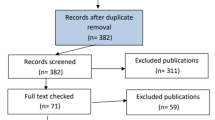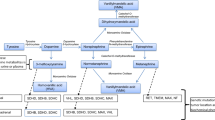Abstract
Aim
Pituitary adenomas are rare in childhood in contrast with adults. Adrenocorticotropic hormone (ACTH)-secreting adenomas account for Cushing’s disease (CD) which is the most common form of ACTH-dependent Cushing’s syndrome (CS). Treatment strategies are generally based on data of adult CD patients, although some difficulties and differences exist in pediatric patients. The aim of this study is to share our experience of 10 children and adolescents with CD.
Patients and method
Medical records, images, and operative notes of 10 consecutive children and adolescents who underwent transsphenoidal surgery for CD between 1999 and 2014 in Cerrahpasa Faculty of Medicine were retrospectively reviewed. Mean age at operation was 14.8 ± 4.2 years (range 5–18). The mean length of symptoms was 24.2 months. The mean follow-up period was 11 years (range 4 to 19 years).
Results
Mean preoperative cortisol level was 23.435 μg/dl (range 8.81–59.8 μg/dl). Mean preoperative ACTH level was 57.358 μg/dl (range 28.9–139.9 μg/dl). MR images localized microadenoma in three patients (30%), macroadenoma in four patients (40%) in our series. Transsphenoidal microsurgery and endoscopic transsphenoidal surgery were performed in 8 and 2 patients respectively. Remission was provided in 8 patients (80%). Five patients (50%) met remission criteria after initial operations. Three patients (30%) underwent additional operations to meet remission criteria.
Conclusion
Transsphenoidal surgery remains the mainstay therapy for CD in pediatric patients as well as adults. It is an effective treatment option with low rate of complications. Both endoscopic and microscopic approaches provide safe access to sella and satisfactory surgical results.
Similar content being viewed by others
References
Savage MO, Dias RP, Chan LF, Afshar F, Plowman NP, Matson M, Grossman AB, Storr HL (2010) Diagnosis and treatment of Cushing’s disease in children. Endocr Dev 17:134–145. https://doi.org/10.1159/000262535
Oliveira RS, Castro M, Antonini SR, Martinelli CE Jr, Moreira AC, Machado HR (2010) Surgical management of pediatric Cushing’s disease: an analysis of 15 consecutive cases at a specialized neurosurgical center. Arquivos brasileiros de endocrinologia e metabologia 54(1):17–23
Yordanova G, Martin L, Afshar F, Sabin I, Alusi G, Plowman NP, Riddoch F, Evanson J, Matson M, Grossman AB, Akker SA, Monson JP, Drake WM, Savage MO, Storr HL (2016) Long-term outcomes of children treated for Cushing’s disease: a single center experience. Pituitary 19(6):612–624. https://doi.org/10.1007/s11102-016-0756-8
Guaraldi F, Storr HL, Ghizzoni L, Ghigo E, Savage MO (2014) Paediatric pituitary adenomas: a decade of change. Horm Res Paediatr 81(3):145–155. https://doi.org/10.1159/000357673
Lonser RR, Wind JJ, Nieman LK, Weil RJ, DeVroom HL, Oldfield EH (2013) Outcome of surgical treatment of 200 children with Cushing’s disease. J Clin Endocrinol Metab 98(3):892–901. https://doi.org/10.1210/jc.2012-3604
Zhan R, Xu G, Wiebe TM, Li X (2015) Surgical outcomes of the endoscopic transsphenoidal route to pituitary tumours in paediatric patients >10 years of age: 5 years of experience at a single institute. Arch Dis Child 100(8):774–778. https://doi.org/10.1136/archdischild-2015-308365
Storr HL, Drake WM, Evanson J, Matson M, Berney DM, Grossman AB, Akker SA, Monson JP, Alusi G, Savage MO, Sabin I (2014) Endonasal endoscopic transsphenoidal pituitary surgery: early experience and outcome in paediatric Cushing’s disease. Clin Endocrinol 80(2):270–276. https://doi.org/10.1111/cen.12275
Pledger CL, Elzoghby MA, Oldfield EH, Payne SC, Jane JA Jr (2016) Prospective comparison of sinonasal outcomes after microscopic sublabial or endoscopic endonasal transsphenoidal surgery for nonfunctioning pituitary adenomas. J Neurosurg 125(2):323–333. https://doi.org/10.3171/2015.6.JNS142695
Massimi L, Rigante M, D'Angelo L, Paternoster G, Leonardi P, Paludetti G, Di Rocco C (2011) Quality of postoperative course in children: endoscopic endonasal surgery versus sublabial microsurgery. Acta Neurochir 153(4):843–849. https://doi.org/10.1007/s00701-010-0929-6
Savage MO, Storr HL (2012) Pediatric Cushing’s disease: management issues. Indian J Endocrinol Metab 16(Suppl 2):S171–S175. https://doi.org/10.4103/2230-8210.104032
Jagannathan J, Dumont AS, Jane JA Jr, Laws ER Jr (2005) Pediatric sellar tumors: diagnostic procedures and management. Neurosurg Focus 18(6A):E6
Valassi E, Feelders R, Maiter D, Chanson P, Yaneva M, Reincke M, Krsek M, Toth M, Webb SM, Santos A, Paiva I, Komerdus I, Droste M, Tabarin A, Strasburger CJ, Franz H, Trainer PJ, Newell-Price J, Wass JA, Papakokkinou E, Ragnarsson O, Group ES (2018) Worse health-related quality of life at long-term follow-up in patients with Cushing’s disease than patients with cortisol producing adenoma. Data from the ERCUSYN. Clin Endocrinol 88(6):787–798. https://doi.org/10.1111/cen.13600
Evang JA, Carlsen SM, Svartberg J, Aanderud S, Johannesen O, Schreiner T, Ramm-Pettersen J, Bakke SJ, Lund-Johansen M, Bollerslev J (2006) Endogenous Cushing’s syndrome. Tidsskrift for den Norske laegeforening : tidsskrift for praktisk medicin, ny raekke 126(5):599–602
Shirvani M, Motiei-Langroudi R, Sadeghian H (2016) Outcome of microscopic transsphenoidal surgery in Cushing disease: a case series of 96 patients. World Neurosurgery 87:170–175. https://doi.org/10.1016/j.wneu.2015.11.046
Kuo CH, Yen YS, Wu JC, Chen YC, Huang WC, Cheng H (2015) Primary endoscopic transnasal transsphenoidal surgery for magnetic resonance image-positive Cushing disease: outcomes of a series over 14 years. World Neurosurg 84(3):772–779. https://doi.org/10.1016/j.wneu.2015.04.059
Osswald A, Plomer E, Dimopoulou C, Milian M, Blaser R, Ritzel K, Mickisch A, Knerr F, Stanojevic M, Hallfeldt K, Schopohl J, Kuhn KA, Stalla G, Beuschlein F, Reincke M (2014) Favorable long-term outcomes of bilateral adrenalectomy in Cushing’s disease. Eur J Endocrinol 171(2):209–215. https://doi.org/10.1530/EJE-14-0214
Kakade HR, Kasaliwal R, Khadilkar KS, Jadhav S, Bukan A, Khare S, Budyal SR, Goel A, Lila AR, Bandgar T, Shah NS (2014) Clinical, biochemical and imaging characteristics of Cushing’s macroadenomas and their long-term treatment outcome. Clin Endocrinol 81(3):336–342. https://doi.org/10.1111/cen.12442
Clayton RN, Jones PW, Reulen RC, Stewart PM, Hassan-Smith ZK, Ntali G, Karavitaki N, Dekkers OM, Pereira AM, Bolland M, Holdaway I, Lindholm J (2016) Mortality in patients with Cushing’s disease more than 10 years after remission: a multicentre, multinational, retrospective cohort study. Lancet Diabetes Endocrinol 4(7):569–576. https://doi.org/10.1016/S2213-8587(16)30005-5
Graham KE, Samuels MH, Nesbit GM, Cook DM, O'Neill OR, Barnwell SL, Loriaux DL (1999) Cavernous sinus sampling is highly accurate in distinguishing Cushing’s disease from the ectopic adrenocorticotropin syndrome and in predicting intrapituitary tumor location. J Clin Endocrinol Metab 84(5):1602–1610. https://doi.org/10.1210/jcem.84.5.5654
Bonelli FS, Huston J 3rd, Carpenter PC, Erickson D, Young WF Jr, Meyer FB (2000) Adrenocorticotropic hormone-dependent Cushing’s syndrome: sensitivity and specificity of inferior petrosal sinus sampling. AJNR Am J Neuroradiol 21(4):690–696
Flitsch J, Ludecke DK, Knappe UJ, Grzyska U (2002) Cavernous sinus sampling in selected cases of Cushing’s disease. Exp Clin Endocrinol Diabetes 110(7):329–335. https://doi.org/10.1055/s-2002-34989
Burkhardt T, Flitsch J, van Leyen P, Sauer N, Aberle J, Grzyska U, Ludecke DK (2015) Cavernous sinus sampling in patients with Cushing’s disease. Neurosurg Focus 38(2):E6. https://doi.org/10.3171/2014.10.FOCUS14687
Teramoto A, Nemoto S, Takakura K, Sasaki Y, Machida T (1993) Selective venous sampling directly from cavernous sinus in Cushing’s syndrome. J Clin Endocrinol Metab 76(3):637–641. https://doi.org/10.1210/jcem.76.3.8383143
Teramoto A, Yoshida Y, Sanno N, Nemoto S (1998) Cavernous sinus sampling in patients with adrenocorticotrophic hormone-dependent Cushing’s syndrome with emphasis on inter- and intracavernous adrenocorticotrophic hormone gradients. J Neurosurg 89(5):762–768. https://doi.org/10.3171/jns.1998.89.5.0762
Ludecke DK (1989) Intraoperative measurement of adrenocorticotropic hormone in peripituitary blood in Cushing’s disease. Neurosurgery 24(2):201–205
Babu R, Back AG, Komisarow JM, Owens TR, Cummings TJ, Britz GW (2013) Symptomatic Rathke’s cleft cyst with a co-existing pituitary tumor; brief review of the literature. Asian J Neurosurg 8(4):183–187. https://doi.org/10.4103/1793-5482.125662
Nishio S, Mizuno J, Barrow DL, Takei Y, Tindall GT (1987) Pituitary tumors composed of adenohypophysial adenoma and Rathke’s cleft cyst elements: a clinicopathological study. Neurosurgery 21(3):371–377
Sumida M, Migita K, Tominaga A, Iida K, Kurisu K (2001) Concomitant pituitary adenoma and Rathke’s cleft cyst. Neuroradiology 43(9):755–759
Wu W, Jia G, Jia W, Li G, Zhang J, Zhang L (2018) Pituitary adenoma associated with Rathke’s cleft cyst: report of 15 cases. J Can Sci Neurol 45(1):68–75. https://doi.org/10.1017/cjn.2017.252
Biller BM, Grossman AB, Stewart PM, Melmed S, Bertagna X, Bertherat J, Buchfelder M, Colao A, Hermus AR, Hofland LJ, Klibanski A, Lacroix A, Lindsay JR, Newell-Price J, Nieman LK, Petersenn S, Sonino N, Stalla GK, Swearingen B, Vance ML, Wass JA, Boscaro M (2008) Treatment of adrenocorticotropin-dependent Cushing’s syndrome: a consensus statement. J Clin Endocrinol Metab 93(7):2454–2462. https://doi.org/10.1210/jc.2007-2734
Hofmann BM, Hlavac M, Martinez R, Buchfelder M, Muller OA, Fahlbusch R (2008) Long-term results after microsurgery for Cushing disease: experience with 426 primary operations over 35 years. J Neurosurg 108(1):9–18. https://doi.org/10.3171/JNS/2008/108/01/0009
Vance ML (2009) Cushing’s disease: radiation therapy. Pituitary 12(1):11–14. https://doi.org/10.1007/s11102-008-0117-3
Tritos NA, Biller BM (2015) Update on radiation therapy in patients with Cushing’s disease. Pituitary 18(2):263–268. https://doi.org/10.1007/s11102-014-0615-4
Loeffler JS, Shih HA (2011) Radiation therapy in the management of pituitary adenomas. J Clin Endocrinol Metab 96(7):1992–2003. https://doi.org/10.1210/jc.2011-0251
Castinetti F, Nagai M, Dufour H, Kuhn JM, Morange I, Jaquet P, Conte-Devolx B, Regis J, Brue T (2007) Gamma knife radiosurgery is a successful adjunctive treatment in Cushing’s disease. Eur J Endocrinol 156(1):91–98. https://doi.org/10.1530/eje.1.02323
Jagannathan J, Sheehan JP, Pouratian N, Laws ER, Steiner L, Vance ML (2007) Gamma Knife surgery for Cushing’s disease. J Neurosurg 106(6):980–987. https://doi.org/10.3171/jns.2007.106.6.980
Hoybye C, Grenback E, Rahn T, Degerblad M, Thoren M, Hulting AL (2001) Adrenocorticotropic hormone-producing pituitary tumors: 12- to 22-year follow-up after treatment with stereotactic radiosurgery. Neurosurgery 49(2):284–291 discussion 291-282
Losa M, Picozzi P, Redaelli MG, Laurenzi A, Mortini P (2010) Pituitary radiotherapy for Cushing’s disease. Neuroendocrinology 92(Suppl 1):107–110. https://doi.org/10.1159/000314299
Author information
Authors and Affiliations
Corresponding author
Ethics declarations
Conflict of interest
There are no conflicts of interest.
Additional information
Publisher’s note
Springer Nature remains neutral with regard to jurisdictional claims in published maps and institutional affiliations.
Rights and permissions
About this article
Cite this article
Gazioglu, N., Canaz, H., Camlar, M. et al. Neurosurgical treatment of Cushing disease in pediatric patients: case series and review of literature. Childs Nerv Syst 35, 2127–2132 (2019). https://doi.org/10.1007/s00381-018-4013-5
Received:
Accepted:
Published:
Issue Date:
DOI: https://doi.org/10.1007/s00381-018-4013-5




